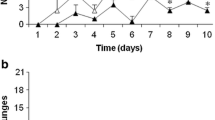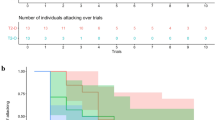Abstract
Snakes are obligate predatory organisms that consume prey whole, and despite their precocious nature, snakes must develop effective feeding skills, especially when encountering large prey. I conducted two experiments that document the development of behavioral repertoires for naïve hatchling trinket snakes, Coleognathus helena. In the first experiment, I examined how experience with prey of different relative prey mass encountered at regular feeding intervals affects hatchling feeding response. I also examined whether hatchling feeding performance improved over time. Improvement was evaluated on the frequency of the most effective behavioral states such as complex prey restraint behaviors and anterior-first ingestion. In the second experiment I tested whether feeding experience with prey of a particular size influences the way hatchlings respond to a novel prey size. All hatchlings improved their predatory behavior when prey size and number of trials were controlled. Hatchlings feeding on larger prey, however, showed greater overall improvement in their feeding behavior and were quick to integrate complex prey restraint behaviors such as constriction into their feeding repertoire. Despite the fact that early experience with one prey size seemed to shape their restraint repertoire during their first four feeding events, hatchlings remained flexible and responded to prey of a novel size with size-specific prey restraint behaviors.


Similar content being viewed by others
References
Annett J (1985) Motor learning: a review. In: Heuer H, Kleinbeck U, Schmidt K (eds) Motor behavior: programming, control, and acquisition. Springer, Berlin, pp 189–212
Arnold SJ (1978) Some effects of early experience on feeding responses in the common garter snake, Thamnophis sirtalis. Anim Behav 26:455–462
Arnold SJ (1993) Foraging theory and prey-size-predator-size relations in snakes. In: Seigel RA, Collins JT (eds) Snakes: ecology and behavior. McGraw-Hill, Inc., New York, pp 87–115
Bealor MT, Saviola AJ (2007) Behavioural complexity and prey-handling ability in snakes: gauging the benefits of constriction. Behaviour 144:907–929
Burghardt GM (1978) Behavioral ontogeny in reptiles: whence, whither, and why? In: Burghardt GM, Bekoff M (eds) The development of behavior. Garland, New York, pp 149–174
Burghardt GM (1992) Prior exposure to prey cues influences chemical prey preference and prey choice in neonatal garter snakes. Anim Behav 44:787–789
Cundall D, Greene HW (2000) Feeding in snakes. In: Schwenk K (ed) Feeding: form, function, and evolution in tetrapod vertebrates. Academic, San Diego, pp 293–333
Diefenbach CO, Emslie SG (1971) Cues influencing the direction of prey ingestion of the Japanese rat snake, Elaphe climacophora (Colubridae, Serpentes). Herpetologica 27:461–466
de Queiroz A (1984) Effects of prey type on the prey-handling behavior of the bull snake, Pituophis melanoleucus. J Herpetol 18:333–336
de Queiroz A, de Queiroz K (1987) Prey-handling behavior of Eumeces gilberti with comments on head first ingestion in squamates. J Herpetol 21:57–63
de Queiroz A, Groen RR (2001) The inconsistent and inefficient constricting behavior of Colorado western terrestrial garter snakes, Thamnophis elegans. J Herpetol 35:450–456
Fuchs JL, Burghardt GM (1971) Effects of early feeding experience in responses of garter snake food chemicals. Learn Motiv 2:271–279
Greene HW (1976) Scale overlap, a directional sign stimulus for prey ingestions by ophiophagous snakes. Z Tierpsychol 41:113–120
Krause MA, Burghardt GM (2001) Neonatal plasticity and adult foraging behavior in garter snakes, Thamnophis sirtalis, from two nearby, but ecologically dissimilar, habitats. Herpetol Monogr 15:100–123
Lind AJ, Welsh HH Jr (1994) Ontogenetic changes in foraging behavior and habitat use by the Oregon garter snake, Thamnophis atratus hydrophilus. Anim Behav 48:1261–1273
Loop MS, Bailey LG (1972) The effects of relative prey size on the ingestion behavior of rodent-eating snakes. Psychon Sci 28:167–169
Mehta RS (2003) The effects of prey-size on the prey-handling behavior of hatchling Elaphe helena. Herpetologica 4:471–476
Moon BR (2000) The mechanics and muscular control of constriction in gopher snakes (Pituophis melanoleucus) and a king snake (Lampropeltis getula). J Zool 252:83–98
Moon BR, Tullis A (2006) The ontogeny of contractile performance and metabolic capacity in a high-frequency muscle. Physiol Biochem Zool 79:20–30
Mori A (1991) Effects of prey size and type on prey-handling behavior in Elaphe quadrivirgata. J Herpetol 25:160–166
Mori A (1993a) Does feeding experience with different size of prey influence the subsequent prey-handling behavior in Elaphe climacophora? J Ethol 11:153–156
Mori A (1993b) Prey handling behavior of neonatal rat snakes, Elaphe taeniura and E. dione (Colubridae). Jpn J Herpetol 15:59–63
Mori A (1994) Prey-handling behavior of newly hatched snakes in two species of the genus Elaphe with comparison to adult behavior. Ethology 97:198–214
Mori A (1995) Prey-restraint behavior of the young rat snake Elaphe taeniura (Squamata: Reptilia). Mem Fac Sci Kyoto Univ Ser Biol 16:43–47
Mori A (2006) Is headfirst ingestion essential in gape-limited predators? Prey-handling behavior of the anurophagous snake Rhabdophis tigrinus (Colubridae). Can J Zool 84:954–963
Morse DH (1980) Behavioral mechanisms in ecology. Harvard University Press, Cambridge
Morse DH (2000) The effect of experience on the hunting success of newly emerged spiderlings. Anim Behav 60:827–835
Mushinsky HR (1987) Foraging ecology. In: Seigel RA, Collins JT, Novak SS (eds) Snakes: ecology and evolutionary biology. MacMillan Publishing Co., New York, pp 302–334
Pough FH (1978) Ontogenetic changes in endurance in water snakes (Natrix sipedon): physiological correlates and ecological consequences. Copeia 1978:69–75
Savitsky BA, Burghardt GM (2000) Ontogeny of predatory behavior in the aquatic snake specialist, Nerodia rhombifer, during the first year of life. Herpetol Monogr 14:401–419
Schmidt RA (1991) Motor learning and performance: from principles to practice. Human Kinetics, Champaign
Siegel S, Castellan NJ Jr (1988) Nonparametric statistics for the behavioral sciences, 2nd edn. McGraw-Hill, Inc., New York
Sokal RR, Rohlf FJ (1981) Biometry: the principles and practice of statistics in biological research. WH Freeman and company, New York
Utiger U, Helfenberger N, Schaetti B, Schmidt C, Ruf M, Ziswiler V (2002) Molecular systematics and phylogeny of Old and New World ratsnakes, Elaphe auct., and related genera (Reptilia, Squamata, Colubridae). Russ J Herpetol 9:105–124
Waters MR, Burghardt GM (2004) The interaction of food motivation and experience in the ontogeny of chemoreception in crayfish snakes. Anim Behav 69:363–374
Acknowledgments
I thank Neil Ford, Don Killebrew, James Koukl, and Darrell Pogue for help with experimental design and advice throughout the study. I thank Gordon Burghardt, the Burghardt Lab, and Jonathon Redwine for comments on the manuscript. Neil Ford provided the animals for this study. Animals were kept in captivity in accordance with the University of Texas, Tyler Animal Care Protocol.
Author information
Authors and Affiliations
Corresponding author
About this article
Cite this article
Mehta, R.S. Early experience shapes the development of behavioral repertoires of hatchling snakes. J Ethol 27, 143–151 (2009). https://doi.org/10.1007/s10164-008-0097-9
Received:
Accepted:
Published:
Issue Date:
DOI: https://doi.org/10.1007/s10164-008-0097-9




